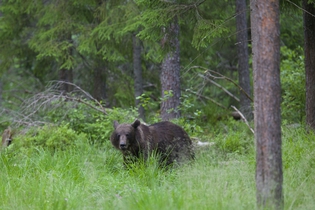Bilberries and bears
Text, photos and video record by Tiit Hunt, www.rmk.ee
Translation Liis
It is the time to head for the forest – for the bilberry forest. .
The places where the bilberry shrubs in flower were not hit by night frosts are now blue and black from delicious berries.
The bilberry time attracts both us and bears into the berry forest. It is very likely that the best bilberry spot in the forest is where the bear eats bilberries – bears know. Berry-pickers try to find the best berry spots too, and so the probability to get into the same forest as a bear is greater in berry times, and in the best, or worst, case we might even stand eye to eye with the large creature.
About 750 bears live in the Estonian forests, but despite this no-one should leave off going into the forest for fear of the large predator. Bears, as our other large predators, are shy of humans and try to get away in good time. But picking berries intently and quietly it is still useful to take a watchful look from time to time on the surrounding forest, to prevent a ”scary” situation already early on.
Bilberry Harilik mustikas Vaccinium myrtillus
Young bear cubs born last year and separated from their mother this spring are most often encountered. They are still learning to live an independent life. These young juvenile-sized bear cubs are curious and inexperienced and may come quite near without feeling the smell of a human. A crouching berry picker the young bear might first believe to be the sibling that also left in spring and whom it would be a pleasure to see again and sniff. When the young creature realises that it is a human being instead it always flees.
The threat instinct of the cubs born this spring has not developed yet and so they can run to a human in the forest before the female bear has had time to warn them. But these occasions are very rare.
The situation is worse when a little bear cub looks out from behind the same bilberry clump, and the berry picker has come between the mother and the cubs.
In this case the following facts may be helpful:
- Even when protecting her cubs attack is the last action of the female bear because the dread of humans is so great.
- Generally the situation is resolved with angry noises and a simulated attack by the bear.
- If a bear wants to attack it does so on its four feet.
- A bear never hits with the paw but bites, and not with the aim to kill.
- A bear rises on its hind legs to get a better overview of the surroundings and this position is in no way linked to aggression.
If you should meet a bear at a threatening distance, try to withdraw calmly while constantly observing the bear. It might succeed.
A plentiful bilberry harvest!
Brown bear










